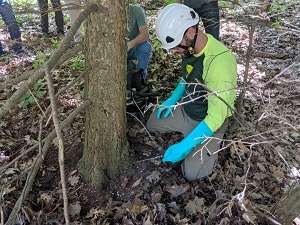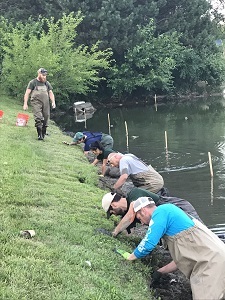|
Sept. 1, 2021
Contact: Joanne Foreman, 517-284-5814 or Erin Campbell, 269-300-9698
Proposals accepted through Nov. 1
Michigan’s Invasive Species Grant Program is now accepting proposals for the 2021 funding cycle, with an anticipated $3.6 million available to applicants.
The program – a joint effort of the Michigan departments of Natural Resources; Environment, Great Lakes, and Energy; and Agriculture and Rural Development – is part of a statewide initiative launched in 2014 to help prevent, detect and control invasive species in Michigan.
An invasive species is one that is not native and whose introduction causes harm, or is likely to cause harm, to Michigan's environment, economy or human health.
“By engaging the public more actively and encouraging innovative new methods of keeping our Great Lakes water and land healthy this program will continue to be an asset in the battle against invasives,” said Liesl Clark, EGLE director.
Program handbook, webinar
The 2021 grant program handbook outlines program priorities and application guidelines. Applicants also can take advantage of a webinar Wednesday, Sept. 8, to learn more about general grant information, the application process and 2021 priorities.
Both the handbook and webinar registration information are available at Michigan.gov/MISGP. A recorded version of the webinar will be available at this website after Sept. 8.
2021 priorities
The program supports projects that will prevent the introduction or spread of invasive species by engaging the public in prevention practices and reducing the risk of moving invasive species into high-risk areas.
Proposals aiding early detection and response efforts for species on Michigan’s Watch List and proposals increasing regional or statewide response preparedness for new or emerging invasive species are also requested.

To manage invasive species already established in Michigan, the program targets proposals for novel and efficient control techniques and projects that improve detection and control methods through increased understanding of species biology and ecology.
Proposals to develop or improve tools, such as risk assessments and prioritization models, to inform management and control decisions also are encouraged.
Support is offered to Cooperative Invasive Species Management Areas across the state to implement strategic plans for outreach, detection and control of regional priority species.
|
Program progress
The Michigan Invasive Species Grant Program supports projects throughout the state that prevent, detect, manage and eradicate invasive species on the ground and in the water. Total program funding is set by the Legislature and the governor during the annual budget cycle.

In the last seven years, the program has awarded over $25 million to 173 projects, resulting in management of invasive species including hemlock woolly adelgid, phragmites and red swamp crayfish on more than 60,000 acres of land and water statewide.
Highlights of the 2020 invasive species program are available in the Michigan Invasive Species Program Annual Report, which includes program-funded projects.
Regional Cooperative Invasive Species Management Areas operate in all of Michigan’s 83 counties, assisting the public in identifying and managing invasive species. Contact information for individual CISMAs can be found at Michigan.gov/Invasives in the Take Action section.
|
Important program dates and information
Local, state, federal and tribal units of government, nonprofit organizations and universities may apply for funding to support invasive species projects in Michigan. Full project proposals are due Nov.1. Award announcement is anticipated in March 2022.
Grant requests for general projects can range from a minimum of $25,000 to a maximum of $400,000. CISMAs can request up to $60,000 for annual implementation of prevention, detection and control activities and up to $40,000 for specific survey and treatment projects. Applicants must commit to providing a minimum of 10 percent (in the form of a local match) of the total project cost.
Competitive applications will outline clear objectives, propose significant ecological benefits, demonstrate diverse collaboration and show strong community support.
New this year, all applications must be submitted through the MiGrants online system. Applicants can access the system at MiGrants.Intelligrants.com or follow the link at Michigan.gov/MISGP.
Michigan's Invasive Species Program is cooperatively implemented by the Department of Environment, Great Lakes, and Energy, the Department of Natural Resources, and the Department of Agriculture and Rural Development.
/Note to editors: Accompanying photos are available below for download. Suggested captions and photo credit information follow:
Tree injection: A certified pesticide applicator prepares a pesticide injection for a hemlock tree infested with hemlock woolly adelgid.
Crayfish: A team from DNR, EGLE and Michigan State University looks for red swamp crayfish in burrows./
|